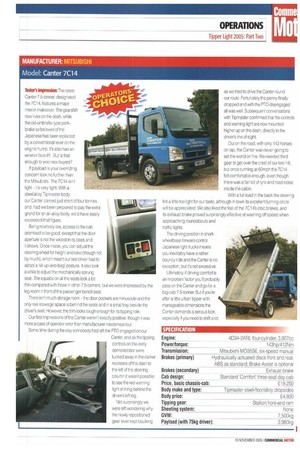Tester's inwessket The latest Canter 7,5-tonner, designated the 7C14, features
Page 57

If you've noticed an error in this article please click here to report it so we can fix it.
a major interior makeover. The gearshift now lives on the dash, while the old umbrella-type parkbrake so beloved of the Japanese has been replaced by a conventional lever on the engine hump. It's also had an exterior face-lift But is that enough to woo new buyers?
If payload is your overriding concern look no further than the Mitsubishi. The 7014 isn't light it's very light. With a steel/alloy Tipmaster body our Canter carried just short of four tonnes and, had we been prepared to pay the extra grand for an all-alloy body, we'd have easily exceeded that figure.
Being relatively low, access to the cab promised to be good. except that the door aperture is not the widest in its class and it shows. Once inside, you can adjust the steering wheel for height and rake (though not by much), which meant our test driver had to adopt a 'sit-up-and-beg' posture. It also took a while to adjust the mechanically sprung seat. The squabs on all the seats look a bit thin compared with those in other 7.5-tonners, but we were impressed by the leg-room in front of the passenger bench seat.
There isn't much storage room -the door pockets are minuscule and the only real stowage space is behind the seats and in a small tray beside the driver's seat. However, the trim looks tough enough for its tipping role.
Our first impressions of the Canter weren't exactly positive, though it was more a case of operator error than manufacturer misdemeanour.
Some time during the day somebody had left the PTO engaged on our Canter, and as the tipping controls on this early demonstrator were tucked away in the darker recesses of the dash to the left of the steering column it wasn't possible to see the red warning light shining behind the driver's left leg.
Not surprisingly we were left wondering why the newly repositioned gear lever kept baulking as we tried to drive the Canter round our route. Fortunately the penny finally dropped and with the PTO disengaged all was well. Subsequent conversations with Tipmaster confirmed that the controls and warning light are now mounted higher up on the dash, directly in the driver's line of sight.
Out on the road, with only 143 horses on tap, the Canter was never going to set the world on fire. We needed third gear to get over the crest of our test hill, but once running at 60mph the 7014 felt comfortable enough. even though there was a fair bit of tyre and road noise inside the cabin.
With a full load in the back the steering felt a little too light for our taste, although in town its excellent turning circle will be appreciated. We also liked the feel of the 7C14's disc brakes, and its exhaust brake proved surprisingly effective at washing off speed when approaching roundabouts and traffic lights.
The driving position in shortwheelbase forward-control Japanese light trucks means you inevitably have a rather bouncy ride and the Canter is no exception, but it's not excessive.
Ultimately, if driving comfort is an important factor you'll probably pass on the Canter and go for a big-cab 7.5-tonner. But if you're after a little urban tipper with manageable dimensions the Canter demands a serious look, especially if you need to shift a lot.






































































































































































































